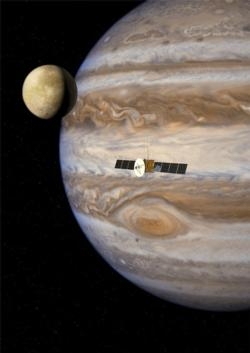JUICE Will Carry 11 Scientific Experiments
The European Space Agency (ESA) has selected instruments that will be launched aboard the JUpiter ICy moons Explorer mission, JUICE, which will carry a total of 11 scientific experiments to study the gas giant planet and its large ocean-bearing moons, ESA announced last week. JUICE is the first Large-class mission in ESA’s Cosmic Vision 2015–2025 programme. Planned for launch in 2022 and arrival at Jupiter in 2030, it will spend at least three years making detailed observations of the biggest planet in the Solar System and three of its largest moons, Ganymede, Callisto and Europa.

These moons are thought to harbour vast water oceans beneath their icy surfaces and JUICE will map their surfaces, sound their interiors and assess their potential for hosting life in their oceans. Today, ESA’s Science Programme Committee approved a complement of instruments that includes cameras and spectrometers, a laser altimeter and an ice-penetrating radar. The mission will also carry a magnetometer, plasma and particle monitors, and radio science hardware. The instruments will be developed by scientific teams from 15 European countries, the US and Japan, through corresponding national funding.
“The selection of JUICE’s instruments is a key milestone in ESA’s flagship mission to the outer Solar System, which represents an unprecedented opportunity to showcase leading European technological and scientific expertise,” says Alvaro Giménez Cañete, ESA’s Director of Science and Robotic Exploration.
“The suite of instruments addresses all of the mission’s science goals, from in-situ measurements of Jupiter’s vast magnetic field and plasma environment, to remote observations of the surfaces and interiors of the three icy moons,” adds Luigi Colangeli, coordinator of ESA’s Solar System Missions.
Throughout its mission, JUICE will observe Jupiter’s atmosphere and magnetosphere, and the interaction of all four Galilean satellites – the three icy moons plus Io – with the gas giant planet. The spacecraft will perform a dozen flybys of Callisto, the most heavily cratered object in the Solar System, and will fly past Europa twice in order to make the first measurements of the thickness of its icy crust. JUICE will end up in orbit around Ganymede, where it will study the moon’s icy surface and internal structure, including its subsurface ocean.
The largest moon in the Solar System, Ganymede is the only one known to generate its own magnetic field, and JUICE will observe the unique magnetic and plasma interactions with Jupiter’s magnetosphere in detail. “Jupiter and its icy moons constitute a kind of mini-Solar System in their own right, offering European scientists and our international partners the chance to learn more about the formation of potentially habitable worlds around other stars,” says Dmitrij Titov, ESA’s JUICE Study Scientist. The selection of the instruments helps to ensure that JUICE remains on schedule for launch in 2022.
(ESA Artist's rendering of JUICE in orbit)
 Sierra Space Repositions Dream Chaser for First Mission
Sierra Space Repositions Dream Chaser for First Mission ANN's Daily Aero-Term (05.10.24): Takeoff Roll
ANN's Daily Aero-Term (05.10.24): Takeoff Roll Aero-News: Quote of the Day (05.10.24)
Aero-News: Quote of the Day (05.10.24) Aero-News: Quote of the Day (05.11.24)
Aero-News: Quote of the Day (05.11.24) ANN's Daily Aero-Term (05.11.24): IDENT Feature
ANN's Daily Aero-Term (05.11.24): IDENT Feature



